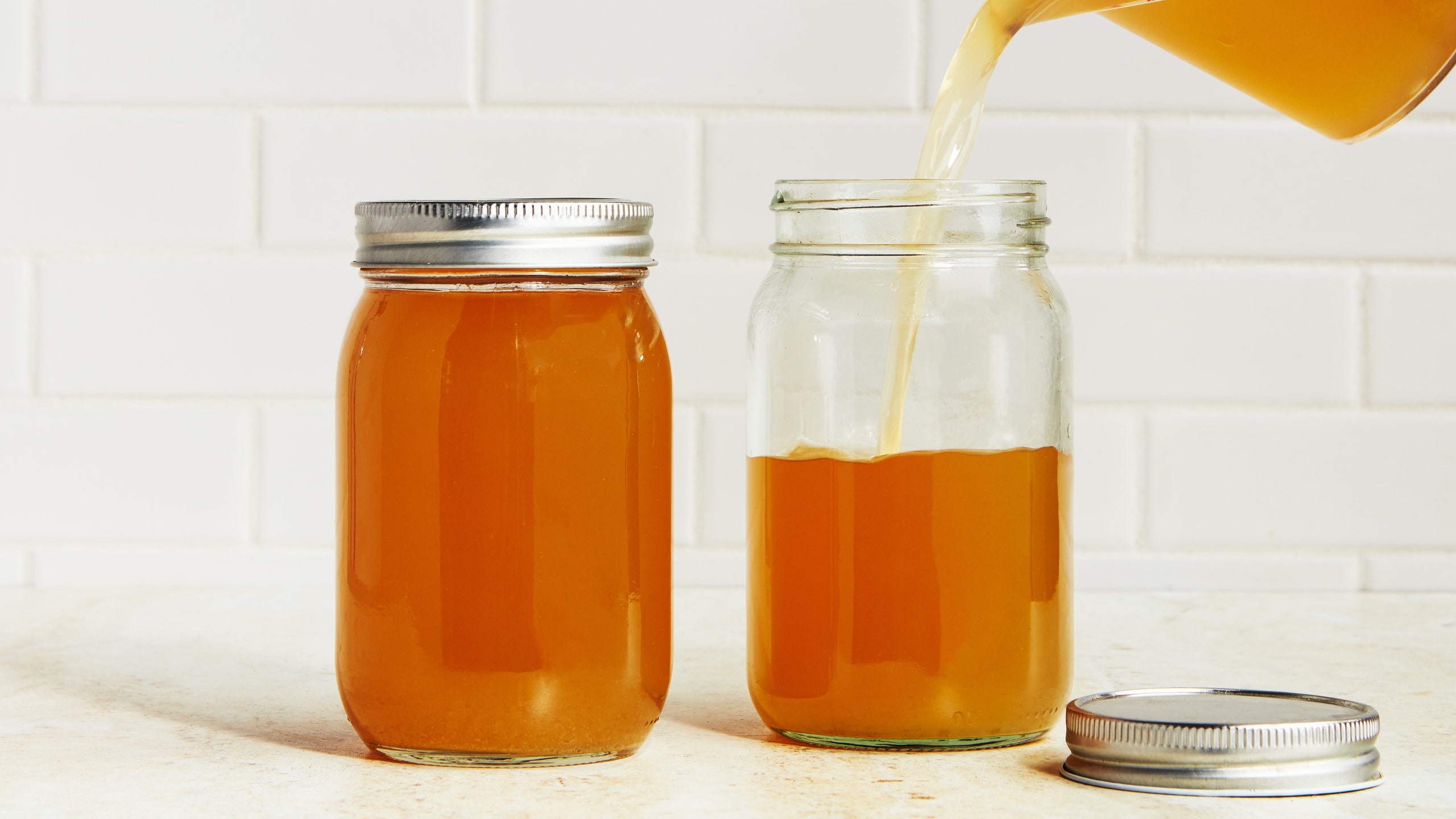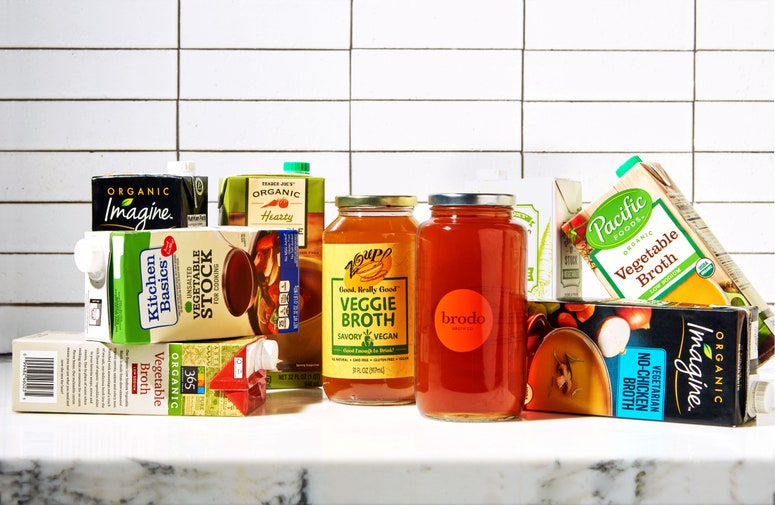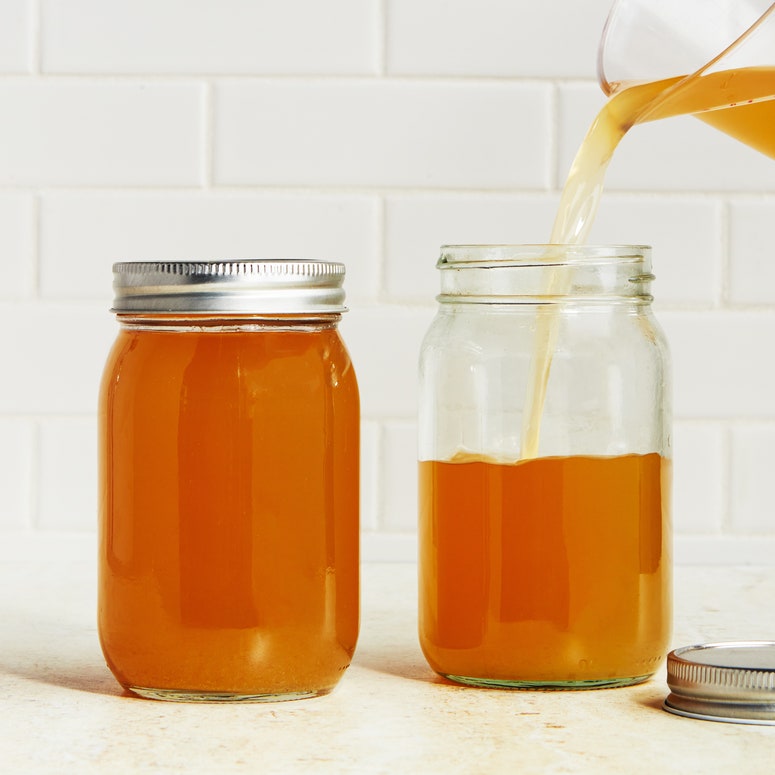What’s the real difference between stock and broth? I used to ask myself that same question every time I wandered down the soup aisle of the grocery store. It certainly doesn’t help that many brands use the terms interchangeably. But there needn’t be such confusion: The distinguishing factors of stock vs. broth—not to mention bone broth—may be murky (just like…a cup of broth), but there are some key differences. Let’s dive in.
The difference between homemade broth, stock, and bone broth:
The primary distinction between broth and stock is how long the liquid is simmered, though a few other nuances set each one apart.
What is broth?: Made by simmering water with vegetables, aromatics, and sometimes animal meat and/or bones for a short period (usually 45 minutes to 2 hours), broth is a light, flavorful liquid that generally stays fluid when chilled. After cooking, it’s strained, seasoned, and usually enjoyed on its own as a soup or a soup base.
What is stock?: Stock is made by simmering water with vegetables, aromatics, and animal bones (sometimes roasted and sometimes with meat still attached) for a slightly longer time, usually 4 to 6 hours. It’s then strained, but not typically seasoned. The extended cook time helps extract the collagen from the connective tissues and bones, which gives stock its rich flavor and mouthfeel. When chilled, good stock should have the texture and jiggle of Jell-O. Stock is not served on its own; instead, it’s used to deglaze a pan or as a base for a rich sauce, gravy, or stew. You can also thin it with water and use it as you would broth.
What is bone broth?: This hybrid of broth and stock is made from roasted bones, sometimes with meat still attached. After cooking, the liquid is strained and seasoned, often meant to be sipped on its own. Bone broth cooks for an extended period—often more than 24 hours—to extract the collagen from the bones and other nutritious compounds and minerals (including glucosamine, amino acids, electrolytes, calcium, gelatin, and more). As such, bone broth is often marketed for its halo of supposed wellness and health benefits, which may be overstated.
Still befuddled by the differences? Consider an example. To make chicken broth, you’ll submerge a whole chicken in a stockpot full of water and aromatics, then simmer the liquid for just over an hour (to make chicken noodle soup, shred the chicken meat and add it back to the broth). The resulting liquid will be clear and sippable. To make homemade chicken stock, skip the whole chicken in favor of chicken bones (the carcass of a rotisserie chicken will work), optionally roasted for 20–45 minutes, until golden or deeply browned. Let the liquid simmer for another 3 hours, drawing the collagen out of the bones to make a richer stock that develops a Jell-O-like wobble as it cools. Simmer for even longer (24-plus hours) to make chicken bone broth, which has the deepest, richest flavor of the three.
Not all broth is made with bones. You can simmer veggies in a pot of water to make vegetable broth. Since they don’t release high quantities of collagen, as animal bones do, the resulting liquid can’t really be called stock, though some store-bought brands market it as such.
Bouillon cubes and powder look like dehydrated stock, but they’re not. The dominant ingredients in chicken or beef bouillon cubes are salt, sugar, and hydrolyzed protein (a compound containing amino acids, often plant-based, but which lend the broth a distinctly savory flavor), with “sufficient chicken and beef extractives to give definite flavor,” according to the FDA. These intensely seasoned cubes also come in flavors like lobster, clam, vegetable, and shrimp bouillon, each with flavor characteristics outlined by the USDA.
Beef or chicken base comes in a jar and is typically made from cooked, ground-up meat with added salt, seasonings, and concentrated stock. Look for a brand that lists meat as the first ingredient—we like the ones from Better Than Bouillon. Both bouillon and base products are extremely salty when reconstituted, so consider them a flavor booster rather than a broth builder.
Another option is chicken powder, seasoned less intensely than other bouillon products, to deliver a pure, complex chicken flavor. The lack of spice or aromatic flavors allows it to blend with a variety of chicken dishes seamlessly; “it works as well in chicken pot pie as it does posole or congee,” writes Epi staffer Wilder Davies.
Going for store-bought? Here’s what to look for.
When it comes to store-bought broth and stock, you can take these rules with a grain of salt. And that’s because the federal government doesn’t distinguish between broth and stock—the terms are used interchangeably on product labels and ingredient panels, says Michael Noble, corporate chef for Ariake USA, a large-scale stock manufacturer (since acquired by Kerry Group). Both terms refer to the liquid produced after simmering bones or meat in water (except in the case of vegetable broth/stock, where vegetables take the place of meat); the only stipulation with beef broth is that it has a ratio of 135 parts moisture to 1 part protein. There is no standard for what’s marketed as “bone broth.”
So packaged stock and broth are essentially the same, whether canned or in cartons. In fact, much of the stock and broth sold by different brands originates from a handful of companies that specialize in making base stocks—or broth, if you prefer; how a specific brand adjusts a base stock before packaging explains the wide range of products. “They can have the same ingredients, but they can all taste different,” says Noble. “Small amounts of seasonings make a huge impact.” Sodium content varies widely between brands, which is why some store-bought broths are much saltier than others. Other common ingredients in packaged broth include maltodextrin, a starch that adds body; yeast extract, a flavor enhancer; caramel color, often used in beef broth to turn it brown; and sweeteners.
Generally, higher protein content means the broth was made with a higher ratio of meat. With beef broths in particular, you also might see hydrolyzed vegetable or soy protein among the ingredients. These are primarily used as flavor enhancers but can also drive up the protein content of store-bought broth, says Noble.
Why you should make your own pot of liquid gold:
Homemade broth, stock, and bone broth are all fairly easy to make at home. Most recipes are highly flexible and range from ones made with all vegetables to ones made with cast-off animal bones to ones made with any combination of meat, bones, and aromatics. Using holiday leftovers to make stock is a great way to stretch the money you spent on the ingredients: Save your Thanksgiving turkey carcass to make turkey stock, ham bones for ham stock, beef bones for bone broth—or any combination of animal bones to make a blended stock. Toss in any wilt-y vegetables lingering in your crisper drawer—carrot, onion, and celery (known as mirepoix when combined) are classic choices, but you can add other root vegetables, herbs, and alliums too. Season with your choice of spices: whole coriander or cumin seeds, peppercorns, bay leaves…we could go on. Make it on the stovetop or in a slow cooker, use it up within a week, or freeze quarts for a future dinner assist.
Speaking of, there are so many ways to use homemade broth and stock. Both form the backbone of countless soups and sauces. Homemade stock is an instant upgrade when making risotto. If you want to get fancy, turn your stock into consommé, a clear soup made by clarifying broth or stock with egg whites.
Homemade broth or stock can be made ahead and stored in the refrigerator or freezer in an airtight container. Most broth and stock can be refrigerated for up to 1 week or frozen for up to 6 months, though the exact shelf life will vary by recipe. If you don’t plan to use a whole quart at once, freeze broth or stock into large ice cubes for easy portioning. If frozen, reheat the broth or stock in a saucepan over low heat before using.
For store-bought broth or stock, follow the advice on the packaging and use the broth, or freeze any extra, within the recommended time—typically a week or up to two weeks after opening. Use it in our favorite soup recipes, like smooth butternut squash soup or an aromatic winter stew with thyme and bay leaves.
Additional reporting contributed by Rhoda Boone and Janet Rausa Fuller.


